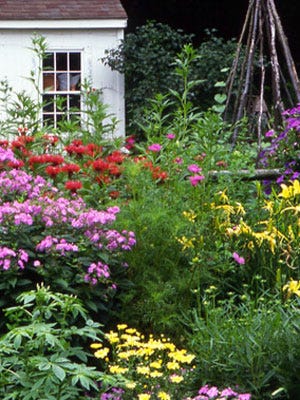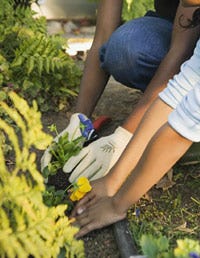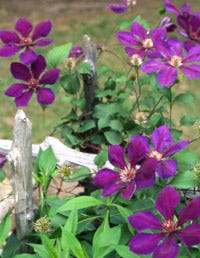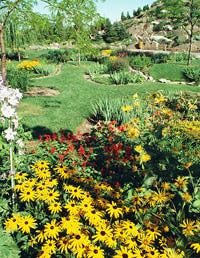How To Keep Squirrels And Chipmunks Out Of Garden

JIU

1. Cook up a splendid plan. Make this the year you grow a plant you've always hankered for, such as anemones in paint-box colors, giant sunflowers and stately hollyhocks. Or, put in a small water feature, a tiny stone-rimmed pond that reflects the sky.
2. Follow the golden rule of gardening: The better the soil, the better the garden. Build good soil, but start with a soil test. For tall, heavy-flowering plants, work in several inches of organic material to improve the soil's balance, texture, and water-holding capacity. Use aged manure, peat moss or compost.
3. Dig into catalogs and read seed packets. Many gardeners skip the fine print on seed packets. This information guides you to the ideal planting depth, spacing and time to plant. Catalogs and magazines inspire, too.
4. Buy favorite annuals in six-packs. But also buy some gallon-size plants for a head start on instant gratification.

5. Shop carefully. Turn over pots—don't buy root-bound plants (those with roots crawling out of the drainage holes), or plants that have dried out. Skip small seedlings already in bloom—they've been forced to flower at the expense of root growth and take longer to rebloom.
6. Indulge—in summer bulbs. Pop them into beds or containers and watch them shoot up. Every year there are more colors, new foliage patterns and some bulbs, like amarcrinum and acidanthera are divinely fragrant. Choose begonias for shade, lilies for sun and caladium and elephant ears to transform any garden into a tropical paradise.
7. Restrain yourself. Don't sow seeds or plant seedlings too early. Resist the temptation to dive into planting on the first warm weekend. Heat- loving summer annuals will not thrive until the soil has warmed up and weather conditions have settled, with outdoor night temperatures consistently in the 50°F range.

8. Thin seedlings. Pull up those that have germinated too close together; save only plants that are at the proper distance apart so they have enough space to thrive. (Check those seed packets.) Unhappy, crowded plants just won't grow well and are disease prone.
9. Shuffle perennials. Clever gardeners move plants around constantly—to adjust color combinations or to make room for a fast-growing plant. Dig out plants carefully, retaining some soil,and water them well in their new homes.
10. Plant pots, in the same way. Consider your container plants as movable design accessories. Reposition them so they get more or less sun, or to fill a bare space on a patio or in a border.
11. Stake tall perennials before it's too late. Fit wire supports over peonies, hollyhocks, veronica and other plants that tend to sprawl. It's harder to stake when the plant has already taken off.

12. Add art. Splurge on a neoclassic birdbath or sundial, or get whimsical with tattered treasures such as an old mirror on a fence or a wooden wheelbarrow for a large container. Or, build or purchase decorative birdhouses.
13. Repeat strong shapes. Break up a long border with groups of mounding shrubs, such as mini-hydrangeas (for example, the new 'Endless Summers'), buddleia (butterfly bush) or dwarf conifers at regular intervals to create smaller sections visually while tying the design together. Gorgeous spires include foxglove, Goat's beard, red-hot poker, iris and spike speedwell.
14. Manipulate your microclimates. A sheltering wall creates a cozy nook for cold-sensitive plants and a full-sun southern exposure is the place to grow roses and other sun/heat-loving plants.
15. Calculate a plant's water needs before you put it in. Using the right species in the right place can save irrigation. Choose native flora already adapted to your environment.

16. Watch your water use. A sprinkler or faucet accidentally left on, forgotten drip irrigation or water splashing on paths not only wastes a precious resource, but can drown seedlings, wash away compost and look very untidy.
17. Keep your plants healthy. Even if you have good soil with high organic content, most plants need added nutrition for best growth, especially in sandy soil. Feed monthly at regular intervals throughout the growing season. Read the directions on the package.
18. Repeat colors and textures to add continuity to your garden's design. Use plants of different shapes and sizes in the same color family, or repeat ferny, glossy or grassy leaves in a border.
19. Try some new-this-year plants. Coneflowers aren't just purple anymore: try the new ones 'Pink Poodle', 'Hot Papaya', 'Tomato Soup' or even 'Mac 'n' Cheese'. Get the whole neighborhood gasping with 'Sun Parasol', a crimson mandevilla vine that blooms till frost.

20. Weed wisely. Can't keep up with daily weeding? Cut the tops off weeds to prevent them from seeding.
21. Patrol your borders. Keep grass from climbing into your flower beds. Edge them with flat stones or a row of bricks for instant definition. Arrange the stones, then lower the soil level on the lawn side about two inches.
22. Keep up the show. Deadheading (or cutting for vases) both annuals and perennials encourages rebloom. Remove dead or drooping blossoms and the show will go on.
23. Go 'Sun Gold'. Even if you have no room for a vegetable patch, fill large containers with compost, fit in a tomato tower and set out 'Sun Gold' cherry tomatoes. They produce abundantly, are high in vitamins and are insanely sweet.
24. Spoil your plants with manure tea. Keep a barrelful—just like a stockpot, adding and stirring—and then dole it out to plants in need. Simply add rotted horse, cow or sheep manure to a large bucket of water and stir.
25. Combine trees, perennials, herbs and vegetables, tropicals, annuals and vines, judging each plant on its own merits. The resulting mix will be eclectic and exciting.
This content is created and maintained by a third party, and imported onto this page to help users provide their email addresses. You may be able to find more information about this and similar content at piano.io
How To Keep Squirrels And Chipmunks Out Of Garden
Source: https://www.womansday.com/home/tips/a598/25-essential-gardening-tips-72071/
Posted by: holtmanlepaso.blogspot.com

0 Response to "How To Keep Squirrels And Chipmunks Out Of Garden"
Post a Comment